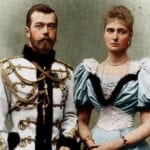 Movies and TV
Movies and TV  Movies and TV
Movies and TV  History
History 10 Things You Never Knew About Presidential First Ladies
 Movies and TV
Movies and TV 10 Zombie Movies That Will Actually Terrify You
 Humans
Humans 10 Times Scientists Were Absolutely Sure… and Absolutely Wrong
 Our World
Our World 10 Pivotal Moments for Life on Earth
 Movies and TV
Movies and TV 10 Most Realistic Medical TV Shows of All Time
 Creepy
Creepy 10 Eerie & Mysterious Ghosts of the Pacific Coast
 Weird Stuff
Weird Stuff 10 Typos That Accidentally Changed History
 History
History 10 Times Trickery Won Battles
 Technology
Technology 10 Awesome Upgrades to Common Household Items
 Movies and TV
Movies and TV 10 Movie Flops That Found Their Way to Cult Classic Status
 History
History 10 Things You Never Knew About Presidential First Ladies
 Movies and TV
Movies and TV 10 Zombie Movies That Will Actually Terrify You
Who's Behind Listverse?

Jamie Frater
Head Editor
Jamie founded Listverse due to an insatiable desire to share fascinating, obscure, and bizarre facts. He has been a guest speaker on numerous national radio and television stations and is a five time published author.
More About Us Humans
Humans 10 Times Scientists Were Absolutely Sure… and Absolutely Wrong
 Our World
Our World 10 Pivotal Moments for Life on Earth
 Movies and TV
Movies and TV 10 Most Realistic Medical TV Shows of All Time
 Creepy
Creepy 10 Eerie & Mysterious Ghosts of the Pacific Coast
 Weird Stuff
Weird Stuff 10 Typos That Accidentally Changed History
 History
History 10 Times Trickery Won Battles
 Technology
Technology 10 Awesome Upgrades to Common Household Items
10 Inventors Who Personally Demonstrated Their Product’s Safety
Two of the names on this list are well-known. However, the others are lesser-known but no less as important. All these inventions, potentially dangerous in themselves, have saved lives, often many, and attracted great attention thanks to the extreme, perilous tests the inventors themselves undertook to prove the safety of their inventions.
Related: Top 10 Amazing Inventions Of The 1900s
10 Elisha Otis
Despite a series of jobs in various businesses, Elisha Otis (1811–1861) never met with much success until 1853, when he thrilled onlookers during an event described as “a dramatic demonstration.”
Riding an open platform up a scaffold resembling the framework of a gigantic guillotine, Otis stood, among barrels and crates, gazing down at the crowd that had assembled to watch the show. People were suspicious of the safety of elevators, fearing that such contraptions might fall, injuring or killing their occupants. Otis’s demonstration would dispel such worries—if he survived.
As the assembly looked on, Otis struck the rope attached to the elevator with an ax, severing it. Surely, in the resulting fall, he would be severely injured, if not killed, the horrified crowd must have thought.
Instead, Otis proved the efficacy of his brake: his safety system worked. Even with the rope severed, the brake prevented the lift from plunging to its destruction and Otis’s injury or death. The public was persuaded that elevators equipped with his invention were safe, and Otis installed his first passenger-carrying safety elevator in a New York department store four years later.
According to Big Ideas That Changed the World, 1.7 million Otis elevators are in service worldwide, not only in skyscrapers but also in such famous landmarks as the Eiffel Tower and the Statue of Liberty.[1]
9 Jonas Salk
“History of Salk: About Jonas Salk,” a 2002 article on the Salk Institute for Biological Studies website, recounts how Dr. Salk (1914–1995) developed and tested the vaccine that has virtually eradicated polio.
As an assistant professor of epidemiology at the University of Michigan, Salk learned from his mentor, Dr. Thomas Francis, Jr., about the process of developing vaccines. Then, as the director of the Virus Research Laboratory at the University of Pittsburgh School of Medicine, Salk put his knowledge to use, developing a vaccine against the polio virus.
His approach, using an inactivated polio virus to stimulate vaccine recipients’ immunity systems, was “contrary to the era’s prevailing scientific opinion.” There was also concern that such an approach might infect those who received immunizations, causing severe illness or even death. To test his vaccine and to allay the public’s fears, Salk vaccinated himself, his wife, their children, his lab assistant, and “volunteers who had not had polio.”
His test was a success, as were those conducted in 1954 on “one million children, ages six to nine,.. .known as the Polio Pioneers.” Salk refused to patent the vaccine or accept money for it, “preferring it [to] be distributed as widely as possible.” In 1963, he founded the Salk Institute for Biological Studies in La Jolla, California.[2]
8 Garrett Morgan
Among other devices, Garrett Morgan (1877–1963), the son of former slaves, not only invented the “three-way traffic signal” but also a fireproof “safety hood.” According to an article on the America Comes Alive website, Morgan was aware that firefighters could fight fires inside buildings only until they were nearly overcome by smoke. After that, they would have to go outside for fresh air, unable to continue their fight against the fire until they recovered.
In a fire, Morgan knew that breathable air was close to the floor since air warmed by the fire would rise. He reasoned that if he could find a way to draw this air into a “breathing mask” worn by a firefighter, the firefighter could remain inside the burning building longer. As the website article explains, “the safety hood he created had two tubes. One sent fresher air from the floor level up into the breathing mask. The second used a valve to prevent the exhaled air from being inhaled again.”
In 1914. aided by investors, Morgan founded the National Safety Device Company to make and sell the fire safety hoods. A gold medal awarded at the Second International Exposition of Safety and Sanitation boosted sales, with New York City’s fire department and others purchasing the device. The hoods proved safe to use during a subway fire rescue.
In 1916, a much more impressive test of the hoods occurred involving the inventor himself and his brother. Cleveland Waterworks laborers were working in a tunnel when an explosion occurred, trapping some and killing others. Two attempts to rescue them failed when overcome by dense smoke and gases, four members of the initial seven-member rescue team died, and the second, eleven-member team was trapped inside the tunnel.
Morgan and his brother Frank tested the mettle of his invention when they joined the rescue effort, donning Morgan’s safety hoods. Among the dead men, the brothers located and rescued the earlier “rescue squad members who were still living.” As a result of their participation, “the Morgan brothers, aided by several volunteers, made additional multiple trips into the mine, rescuing workers one by one. Unfortunately, none of the original 11 workers could have survived as the tunnel had collapsed on them. It was several weeks before those bodies could be retrieved.”
As the website article notes, “the gas masks that were made for use in World War I were modeled after Morgan’s safety hood.”[3]
7 Steve Gass
Steve Gass bet one of his own fingers that his invention, SawStop, would really work. A U.S. patent lawyer, inventor, and a woodworker with a Ph.D. in physics, Gass was aware that table saws cut off operators’ fingers up to ten times a day. He wanted to create a safety feature to prevent more people from undergoing this horrific, traumatic experience.
Gass’s SawStop differentiates between flesh and wood because the former conducts electricity while the latter does not. Gass’s SawStop “induces a high-frequency electrical signal on the blade of a table saw and monitors this signal for changes caused by contact between the blade and a user’s body.” When a change in the electrical signal is detected, SawStop can halt the saw blade “in 1/1000th of a second or less” by forcing “a brake into the teeth of the blade.”
Gass’s video demonstration of SawStop at work proves his invention’s effectiveness. He stuck his own finger into the saw, and he came away unscathed, his finger undamaged and intact. With neither blood nor pain to show for his trouble, Gass succeeded in demonstrating that, as the video’s narrator comments, he is, indeed, “a man who has faith in his creation.” [4]
6 Troy Hurtubise
AIR staff writer Alice Shirrell Kaswell reported that Troy Hurtubise (1963–2001), dressed in the Ursus Mark VI suit of armor, went head-to-head, or “mano a ursus,” with a reluctant 585-kilogram (1,290-pound) adult Kodiak bear. The predator (the bear, not Hurtubise) was leery of his adversary because “Troy Hurtubise looked so scary in his suit.” Only after ten minutes did the Kodiak bear approach him, Kaswell says, while a 157-kilogram (346-pound) grizzly showed no inclination whatsoever to fight the inventor.
When the Kodiak bear finally mustered enough courage to come after Hurtubise, and he “could smell [the animal’s] breath through [his] helmet,” the inventor of the virtually indestructible body shell admitted that he felt terrified and his heart began pounding. The bear’s trainer intervened, refusing to allow a fight between the inventor and the Kodiak bear.
However, the trainer did let Hurtubise enter the grizzly bear’s cage, confident, Hurtubise said, “that even if he took me down, she wouldn’t be able to penetrate the suit, even if she tried all day.” The grizzly was too scared to do anything more but stand “on his hind legs and [bare his] bicuspids.” Since Hurtubise had invented his suit “specifically for grizzly bears, and not Kodiaks, a behemoth subspecies,” he felt vindicated.
An episode of the American TV series Extra, demonstrating the near-invincibility of his suit, made of titanium plastic, rubber, and chain mail, is certainly impressive. Looking something like an oversize robot in his armor, Hurtubise is struck repeatedly in the head with a large stick until it breaks against his helmet.
The results of some of the challenges of his suit were equally impressive. The blast of a 12-gauge shotgun bounces harmlessly off his midriff. A three-hundred-pound log attached to chains and “launched dead center at his chest” merely knocks him down. A three-ton truck traveling at thirty miles per hour runs into him and knocks him down, causing him to roll over the ground. Finally, he throws himself down a ravine, tumbling to the bottom without a scratch.
It seemed doubtful that a grizzly could have put the preservationist to any more of a test than those he’d already passed with flying colors.[5]
5 George Stephenson
On May 25, 1812, a massive explosion occurred inside the Low Main seam at the Felling Colliery between Gateshead and Jarrow in County Durham, UK, when an “ignition of fire-damp” triggered a coal dust explosion so devastating that it “was heard up to 4 miles away.” Ninety-two lives were lost. As a result, George Stephenson (1781–1848), a mechanic who had worked as a firefighter and a brakeman, started experimenting with a safety lamp that could employ a naked flame without igniting an explosion.
The result was his Gordie Lamp. Based on the containment of “burnt air above the flame, and [the permitting of] the firedamp to come in below in a small quantity to be burnt as it came in,” the lamp proved successful. This was especially true after a flaw (“glass breakage”) was overcome when safety glass was later invented.
As his biography reveals, George Stephenson, the inventor himself, in the company of two witnesses, Nicholas Wood and John Moodie, descended into the Killingworth mine shaft, carrying Stephenson’s lamp “to one of the galleries.” These structures were built to contain and isolate highly explosive carbureted hydrogen, so it would not spread into other areas of the mine. There, he found, hissing gas was issuing into the gallery from a fissure in the roof. Despite the presence of the dense gas, the lamp had not caused an explosion.
To test the lamp further, the gas was “collected” inside a “partition” so that it would be even more “liable to ignition.” Both Wood and Moodie, judging the demonstration to be extremely dangerous, retreated to safety, where they watched Stephenson advance, his lamp lit, to “within a few inches of the fissure,” where the current of gas extinguished the lamp’s flame “without exploding the foul air which surrounded the lamp.”
Stephenson had proved, beyond a doubt, that he had invented a safety lamp that was, indeed, safe to use, even in a mine shaft polluted with flammable gas.[6]
4 Sir Humphry Davy
Sir Humphry Davy (1778–1828) invented several products, including a safety lamp, but he personally tested an early anesthetic procedure that he recommended. As an article on The Public Domain Review website explains, “the young English chemist and inventor and future president of the Royal Society began a very radical bout of self-experimentation to determine the effects of inhaling nitrous oxide, more commonly known as ‘Laughing Gas.’”
His assistant, Dr. Kinglake, and Davy collected gas from heated ammonium nitrate crystals in “a green oiled-silk bag.” After passing the bag through steam to remove impurities, Davy inhaled the purified gas through a mouthpiece. He seemed delighted by the results, describing the effects of the gas as exciting “giddiness, flushed cheeks, intense pleasure,” and, in the inventor’s own words, “sublime emotion connected with highly vivid ideas.”
He so enjoyed the experiment that he repeated it numerous times, even going as far as constructing what he called an “air-tight breathing box’” in which he would sit for hours inhaling enormous quantities of gas, having even more intense experiences. One of these sessions nearly cost him his life, but the danger associated with breathing the gas didn’t prevent him from sharing it with such friends as the poets Samuel Taylor Coleridge and Robert Southey. The poets, likewise, recorded their experiences, which Davy collected, along with his own, and published in 1800 as Researches, Chemical and Philosophical.
In 1800, Davy recognized the gas’s “analgesic properties, named it nitrous oxide,” and, despite his near-death from having abused the gas, recommended its medical use to relieve the pain of surgery.[7]
3 Richard Davis
A Detroit mugging led Richard Davis to invent a new “concealable lightweight body armor.” At the time, only flack jackets were available, and criminals could tell, from the bulky appearance of the jackets, that a police officer was wearing the protective gear. Instead of firing at the officer’s chest, the criminal would shoot the officer in the head.
After inventing his thin, lightweight, concealable, metal-free body armor, Davis demonstrated its effectiveness. First, he laid the vest on the ground and shot it with a handgun. Then, he mounted the vest on a post and shot it with a rifle. The body armor passed both tests, but Davis had a third, potentially fatal, test in mind as well.
Donning the gear, he held a handgun toward his abdomen, only inches away, and shot himself before spinning around and firing the weapon at bowling pins lined up on a table to his left. The gunshot, he said, stung “enough to make you mad” and broke the skin, but he was otherwise unharmed.
His invention’s tightly layered nylon with multiple interlaced fibers proved effective, creating “a mesh so dense it dissipates the explosive energy,” preventing the bullet from penetrating the weave. He repeated his demonstration 200 times. The first time, he said, was for science, but “the next two hundred [were] for show business.”
As Professor David Eisenbach, Columbia University historian, noted, Davis had not put his “money where [his] mouth is, but “his life where [his] mouth is.”[8]
2 Jeremiah Raber
While Davis protected the heart (and other vital organs), Jeremiah Raber protected the family jewels. As Ben Hooper observes, Raber took “a bullet to the groin to prove [his] athletic cup’s strength.” His product, the aptly named Nutzshell groin protector, was originally designed for Ultimate Fighting Championship combatants.”
It seems that, like Davis, the Missouri inventor knew the need for publicity and, to promote his Kickstarter campaign to fund the production of his product, he was prepared to put his cup and his own good name to the test by participating in a live, filmed demonstration in which his business partner—an avid hunter—Matt Heck shot a .22-caliber rifle at his groin while Raber sported one of their products. “Don’t try this at home,” Raber warns viewers.
With Raber’s blue jeans and fly unbuttoned and Raber holding the front of the waist apart, Heck, using transparent tape, forms an “X” over the athletic cup. Then, lying on the ground, behind a tripod-mounted rifle set atop a flat stone, Heck aims at his target. Then, Raber, wearing protective goggles, a bulletproof vest, and protective headgear gives him a two-thumbs-up gesture. Finally, the crack of the rifle shot is heard, and the screen goes dark.
As filming resumes, Raber is shown, jeans halfway down his thighs, adjusting the undamaged cup made of ballistic Kevlar. The video then shows the actual shot, as a bullet flicks harmlessly off the surface of the cup, which bounces slightly upon the bullet’s impact. As might be expected, puns abound in the narrator’s account of the demonstration.[9]
1 Nicolas Senn

As James E. Pilcher notes in his peer-reviewed September 1888 article in Annals of Surgery, “The fertile mind of Professor Senn is notable for the originality of its conceptions.” One of these conceptions was Nicolas Senn’s (1844–1908) invention of a procedure to diagnose intestinal perforation. The idea occurred to him when Senn realized that a stomach or intestine wound could be discovered using a process similar to that by which “a plumber locates a leak in a gas pipe.”
Senn hit on the idea of inflating the intestines with a harmless “gas which would escape from the intestinal wound into the peritoneal cavity,” thus making its presence known to the surgeon using “some infallible test.” As a result of several experiments, Senn determined that a rubber balloon holding from 10 to 20 liters (2 to 4 gallons) would be the most efficient and safest instrument for “blowing the gas throughout the bowels for therapeutic or diagnostic purposes.”
One test subject was Senn himself, who discovered, personally, the physical sensations associated with having the gas blown throughout his intestines. He makes careful, detailed notes concerning his perceptions: “The distention of the colon caused simply a feeling of distention along its course. But as soon as the gas escaped into the ileum, colicky pains were experienced, which increased as insufflation advanced, and only ceased after all the gas had escaped, which was the case only after an hour and a half.” The experience, he observed, was distressing. However, his experiments, both on dogs and humans, himself included, “fully demonstrated the safety of pure hydrogen gas when employed in this manner.”
The infallible test by which the location of the perforation of the intestine was made known was provided by the escape of gas through the wound, which produced bubbles. To tell whether the escaping gas was hydrogen, it was ignited, after which the gas would produce “a slight explosive report, and burn with a characteristic blue flame.” The application of a match or lit candle to the escaping gas—a sure sign of the presence of a perforation in the intestine—has the added advantage of sterilizing the wound, making the process both “diagnostic and therapeutic.”[10]








